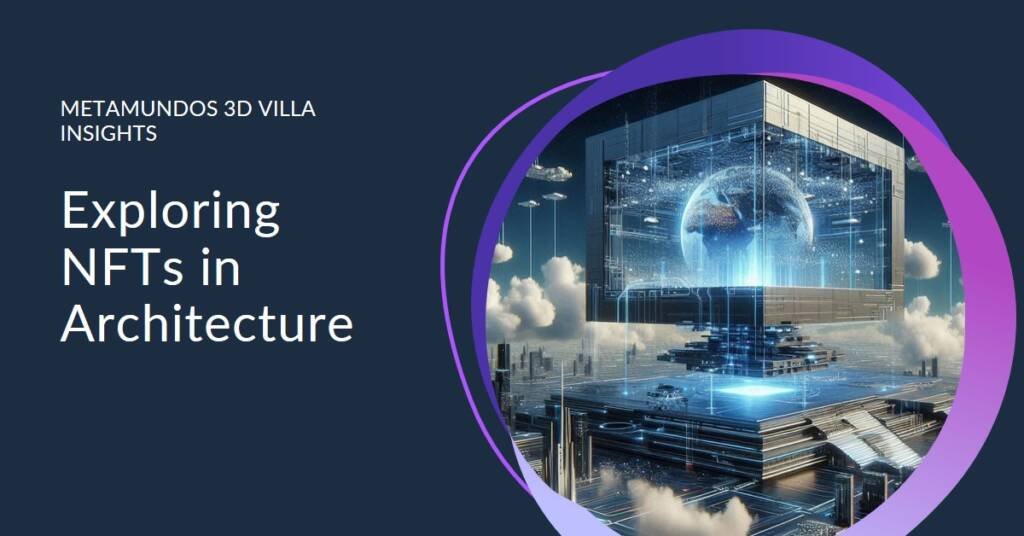
Table of Contents
- Introduction to NFTs and Architecture
- The Emergence of 3D Virtual Architecture
- Introducing Metamundos and Its 3D Villa
- NFTs as Authenticity and Ownership Tools
- The Financial Implications of NFTs in Architecture
- Sustainability and Innovation in Architectural Design
- Challenges and Criticisms Surrounding NFTs in Architecture
- Case Studies of NFT Projects in Architecture
- Future Implications for the Architectural Industry
Introduction to NFTs and Architecture
Non-Fungible Tokens (NFTs) represent a transformative technology within the digital landscape, offering distinct and verifiable ownership of unique digital assets. Unlike cryptocurrencies such as Bitcoin or Ethereum, which are fungible and interchangeable, NFTs are individual tokens with unique metadata that distinguish them from one another. This uniqueness allows for applications across various fields, including art, music, and increasingly, architecture. By integrating blockchain technology, NFTs provide a secure method of ownership, provenance tracking, and a new perspective on asset management.
In the realm of architecture, NFTs can facilitate new ways for architects and designers to create, sell, and maintain digital representations of physical structures. By incorporating NFTs into architectural projects, architects can digitize and tokenize their designs, ensuring authenticity and protecting intellectual property. This approach not only expands the potential market for architectural works but also enhances collaboration among designers, builders, and clients. NFTs can serve as digital certificates of authenticity, ensuring that clients receive genuine versions of architectural plans and designs.
Moreover, NFTs present several advantages, such as enabling the seamless transfer of ownership, lowering barriers to entry for small-scale architects, and fostering a new form of investment in architectural ventures. However, challenges also arise, including environmental concerns associated with blockchain technologies, the volatility of NFT markets, and legal complexities regarding ownership rights. As architects and designers begin to explore the integration of NFTs into their work, it is imperative to navigate these complexities to fully realize the benefits that this innovative approach can bring to the architectural landscape.
The Emergence of 3D Virtual Architecture
The architectural landscape is witnessing a radical transformation with the emergence of 3D virtual architecture. As industries increasingly gravitate towards digital platforms, architects and designers are harnessing advanced technologies to create immersive virtual spaces that redefine the way buildings are conceived and experienced. This shift is not merely a trend; it represents a fundamental evolution in architectural practices, influenced largely by advancements in 3D modeling and virtual reality (VR) technologies.
3D modeling serves as a pivotal foundation for this new approach, allowing architects to develop detailed, accurate representations of structures before they are brought to life in the physical world. This technology enables the visualization of complex designs and facilitates iterative processes through rapid prototyping. As a result, architects can explore creative possibilities and evaluate various design elements in real time, which enhances both innovation and efficiency in the architectural workflow.
Furthermore, virtual reality technology is amplifying the architectural experience by enabling potential clients and stakeholders to engage with spatial designs in an unprecedented manner. VR immerses users in fully realized environments, providing a unique opportunity to navigate and interact with virtual buildings even before construction begins. This greatly enhances communication between architects and clients, allowing for extensive feedback and a more collaborative design process. Users can experience scale, proportions, and lighting effects, thereby making informed decisions based on these immersive encounters.
The rise of 3D virtual architecture also champions accessibility, making architectural spaces more inclusive for a wider range of audiences. As digital platforms evolve, geographical barriers diminish, allowing a global audience to explore and appreciate architectural creations from anywhere in the world. This democratization of access underscores the potential of 3D virtual architecture to inspire, educate, and connect diverse communities around shared architectural experiences. The implications of this emerging trend are profound, positioning the field at the intersection of technology and creativity.
Introducing Metamundos and Its 3D Villa
Metamundos represents a pioneering initiative at the intersection of architecture and non-fungible tokens (NFTs). This innovative project seeks to redefine the spaces we inhabit by creating environments that seamlessly blend digital and real-world experiences. Central to Metamundos is its flagship 3D villa, which exemplifies the potential for NFTs to transform how architectural designs are developed, owned, and experienced.
The design of the Metamundos 3D villa is a remarkable feat of creativity and technology. Built entirely within a virtual environment, this architectural creation showcases modern aesthetics paired with functionality. The villa features expansive open spaces, striking geometric shapes, and meticulously planned layouts, all rendered in high-definition 3D visuals. The integration of sustainable features, such as energy-efficient systems and eco-friendly materials, aligns with contemporary architectural practices. This emphasis on sustainability not only meets aesthetic needs but also addresses growing environmental concerns.
What distinguishes the Metamundos 3D villa is not merely its visual appeal; it serves as a conceptual prototype for future NFT-based architectural projects. By leveraging blockchain technology, each aspect of the villa, from its design to ownership rights, is embedded into the NFT framework. This means that buyers can not only own a unique digital representation of the villa but can also engage in a secure and transparent transaction process. Furthermore, the ability to trade, sell, or lease the NFT deepens the scope of architectural investment.
As the architectural landscape continues to evolve, the Metamundos 3D villa stands as an intriguing example of how the fusion of NFTs and architecture can pave the way for innovative designs and ownership models that may reshape our built environments in the future.
NFTs as Authenticity and Ownership Tools
The emergence of Non-Fungible Tokens (NFTs) in the realm of digital architecture marks a transformative shift concerning authenticity and ownership. NFTs establish a secure and verifiable form of ownership for digital assets, including architectural designs and models. By embedding metadata within the blockchain, NFTs provide indisputable proof that a digital work is original and belongs to a specific individual or entity. This offers architects a structured way to monetize their creations while ensuring that buyers can ascertain the legitimacy of their purchases.
The implications of NFTs extend beyond mere ownership; they are creating a new landscape for property rights in virtual spaces. Whereas traditional real estate transactions involve tangible assets, NFTs are redefining ownership within digital realms. As architects produce virtual designs that exist solely in the digital world, the ownership model adapted with NFTs provides clarity that was previously elusive. Buyers can command a unique piece of digital architecture, accompanied by an NFT that verifies the ownership status.
Additionally, this shift raises critical legal considerations pertaining to intellectual property rights. With the proliferation of NFTs, architects must navigate an evolving legal framework that determines how these digital artifacts are classified and protected. Ownership claims, copyright issues, and derivative works become paramount issues for creators. For instance, if an architect sells an NFT representing their design, questions surrounding the rights to reproduce and distribute that work emerge. The role of NFTs emphasizes the importance of clear legal guidance to protect both creators and buyers in the dynamic digital landscape.
As a result, the intersection of NFTs with architecture represents both opportunities and challenges for the industry. Understanding the mechanics of NFTs can empower architects, buyers, and investors to engage in the digital marketplace with greater confidence and clarity, ultimately reshaping the traditional paradigms of ownership and authenticity in architectural works.
The Financial Implications of NFTs in Architecture
The advent of non-fungible tokens (NFTs) has revolutionized various sectors, and the architectural domain is no exception. NFTs present architects and developers with an innovative way to monetize their designs. By creating unique digital representations of their architectural projects, professionals can offer these as NFTs. This transforms the traditional model of design ownership, allowing creators to sell their work directly to clients or collectors in the digital marketplace. Moreover, the programmable nature of NFTs could allow architects to receive royalty payments whenever their designs are resold, establishing a new income stream and leveraging the resale value of their creations.
Furthermore, the rise of virtual real estate creates opportunities for investment that did not exist previously. As more projects like Metamundos 3D Villa emerge, investors are increasingly attracted to the potential for owning pieces of digital property. Virtual land can be bought, sold, and developed just like physical real estate, albeit within a digital framework. This shift indicates a growing market for virtual developments, where NFTs serve as verifiable ownership documentation, allowing investors to participate in a market defined by scarcity and exclusivity.
Additionally, NFTs can potentially reshape traditional funding and investment methods within the architectural industry. With conventional financing often limited to physical assets, the introduction of NFTs may enable alternative forms of funding, such as crowdfunded projects facilitated by token sales. This could democratize the process of architectural development, allowing a broader range of investors to fund innovative design concepts and elevating the visibility of emerging architects. Thus, the financial landscape of architecture is being significantly influenced by the proliferation of NFTs, marking a robust intersection of creativity, investment, and technology.
Sustainability and Innovation in Architectural Design
The advent of Non-Fungible Tokens (NFTs) in the architectural sphere brings forth a myriad of possibilities, particularly in the context of sustainability. Architects are increasingly tasked with the challenge of designing structures that not only meet the aesthetic desires of clients but also adhere to environmental responsibilities. This juncture between innovation and sustainability highlights how the integration of digital tools and NFTs can facilitate energy-efficient architecture.
One notable approach involves using NFTs to represent digital blueprints and building materials, providing a transparent method for tracking a structure’s lifecycle. By digitizing aspects of construction, architects can optimize resource allocation, reducing waste and promoting the use of renewable materials. Furthermore, the tokenization of properties through NFTs encourages a sustainable mindset, incentivizing developers to invest in eco-friendly designs that appeal to socially conscious consumers. In this regard, NFTs act as a catalyst for sustainable architectural practices, fostering accountability and transparency in environmental impact.
Incorporating innovative design methodologies enabled by NFTs allows architects to simulate potential constructions in a digital environment before any physical work begins. This capability promotes iterative design processes, where sustainable features can be tested and refined without the risk of resource depletion. For instance, virtual reality (VR) and augmented reality (AR) technologies, combined with NFTs, afford architects the tools necessary to visualize energy-efficient solutions in real time, thus leading to more informed decision-making.
Moreover, NFTs have the potential to create a marketplace for sustainable design, allowing clients to engage with eco-focused projects readily. By promoting designs that prioritize sustainability, NFTs can redefine industry standards, setting new benchmarks for energy efficiency and environmental stewardship. Through these avenues, the realm of architectural design is poised for transformation, heralding an era where sustainability becomes intrinsic to architectural innovation.
Challenges and Criticisms Surrounding NFTs in Architecture
The introduction of non-fungible tokens (NFTs) in the architectural domain has evoked a myriad of challenges and criticisms that warrant careful consideration. One prominent concern revolves around the environmental impact associated with blockchain technology, particularly in terms of energy consumption. The majority of leading blockchain networks rely on a proof-of-work consensus mechanism, which requires substantial computational power and, consequently, a significant amount of energy. Critics argue that the carbon footprint generated by these transactions is detrimental, especially in an era where sustainable practices are essential. This raises a crucial question for architects and developers: how can the industry reconcile the innovative potential of digital architecture with pressing environmental obligations?
Accessibility and affordability are further issues integrating NFTs within architecture. The virtual landscape, while offering new dimensions for creativity and expression, often remains out of reach for many potential users. High-profile NFT transactions can lead to inflated prices that question the equity and inclusivity of virtual spaces. Furthermore, the technical know-how required to engage with these platforms creates barriers for those unfamiliar with blockchain technology, exacerbating existing inequities in access to design and architectural endeavors. This exclusivity challenges the foundational purpose of architecture as a discipline meant to serve communities.
Additionally, the speculative nature of NFTs raises alarms regarding the potential for price manipulation and market volatility. Investors may prioritize profit over artistic integrity, consequently driving up prices in a manner that could undermine the architectural value and purpose of these digital creations. The speculative bubble, reminiscent of previous art market phenomena, leads to uncertainty about the longevity of value in the virtual architecture realm. Balancing innovation with ethical considerations remains a pivotal challenge for the architectural community as it navigates the integration of NFTs into its practices.
Case Studies of NFT Projects in Architecture
NFTs have begun to make a significant impact in the field of architecture, offering innovative ways to enhance design, ownership, and engagement with spaces. Several case studies exemplify the successful integration of NFTs into architectural projects, demonstrating unique approaches and the transformative potential of this technology.
One notable example is the collaboration between a prominent architect and a digital artist to create a virtual gallery space as an NFT. This project not only showcased the architectural designs but also allowed art enthusiasts to buy and trade digital representations of the building. By leveraging blockchain technology, the ownership and provenance of these digital assets were secured, leading to increased interest from collectors to explore new avenues of architectural appreciation.
Another case study involved a real estate development that utilized NFTs to represent ownership of virtual land within a metaverse platform. This approach blurred the lines between physical and digital spaces, as buyers could purchase NFTs that corresponded to real-world locations. The integration of NFTs provided a transparent and efficient method for transactions, enhancing engagement through a virtual reality experience where buyers could visualize properties before purchase. However, challenges arose regarding regulatory compliance and market volatility, highlighting the need for strategic planning in the NFT adoption process.
Additionally, a recent architectural design competition embraced NFTs as a means for participants to submit their concepts. Each submission was minted as an NFT, granting the designer copyright and control over the digital representation of their work while promoting wider visibility. This innovative approach facilitated an interactive judging process and encouraged participation from a diverse range of artists and architects. Lessons learned from this initiative suggest that NFTs can significantly enhance engagement and create new channels for exposing architectural creativity.
Overall, these case studies illustrate how NFTs can innovate architectural design and ownership, fostering new forms of engagement. The projects showcase not only the potential but also the challenges and considerations that come with integrating NFTs into architecture, paving the way for future advancements in the field.


Future Implications for the Architectural Industry
The advent of non-fungible tokens (NFTs) has unveiled new frontiers for the architectural industry, particularly through projects like the Metamundos 3D Villa. As the digital landscape continues to evolve, the integration of NFTs in architecture may redefine ownership concepts, design processes, and collaborative frameworks. Industry experts suggest that NFTs could provide architects with innovative tools for enhancing project visibility, which in turn can lead to broader public engagement and investment opportunities.
One significant implication of NFTs is the potential shift in how ownership is perceived within the architectural realm. Traditionally, ownership of architectural designs has been tied to physical models or blueprints, but with the advent of NFTs, architects can create verifiable digital representations of their work. This digital authenticity can empower architects to sell, trade, or license their designs as unique digital assets, fostering a new economy based on digital ownership. As a result, clients may find themselves engaged in a more transparent process, where the value of designs is clearly represented through NFTs.
Moreover, the collaborative dynamics among architects, clients, and stakeholders can evolve significantly with the integration of NFTs. Through blockchain technology, which underpins NFTs, architects can establish secure and enforceable contracts that enhance cooperation and minimize disputes. This could lead to a more collaborative environment where real-time feedback and design modifications are seamlessly integrated, enriching the overall creative process.
In addition to redefining ownership and collaboration, NFTs may encourage a fusion of digital and physical architectural practices. This could manifest in hybrid projects that incorporate both digital designs and physical construction, ultimately leading to buildings that are informed by innovations like augmented and virtual reality. As the architectural industry navigates this transition, ongoing discussions and insights from thought leaders will be vital in shaping a future where NFTs and physical architecture coalesce harmoniously, paving the way for a reimagined architectural landscape.



